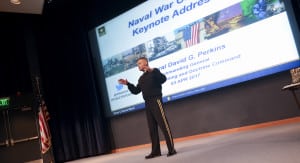
In a future where a soldier in combat on one continent can radio commanders in the United States, potential enemies can use the same technology to launch diversionary attacks at ranges much farther than conventional weapons allow.The Army is brainstorming a battle plan for how to fight future wars where combat will occur on land, at sea, in the air and in space and cyberspace. Technology will have at once shrunk the battlefield by improving data sharing and communication and…

 By
By 











